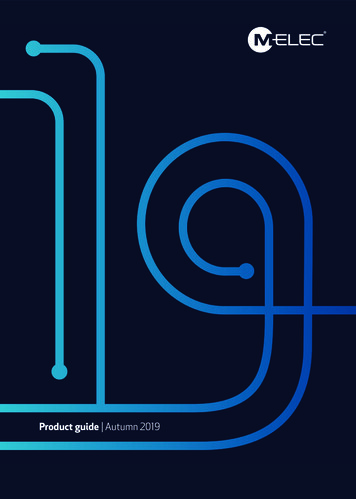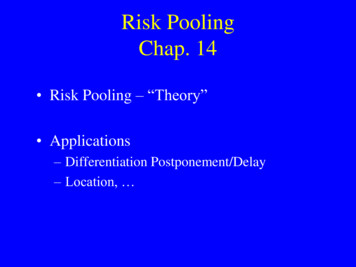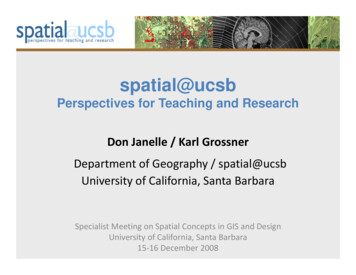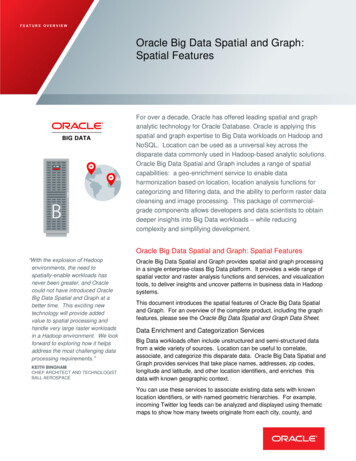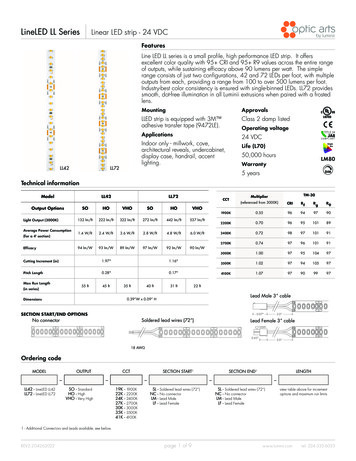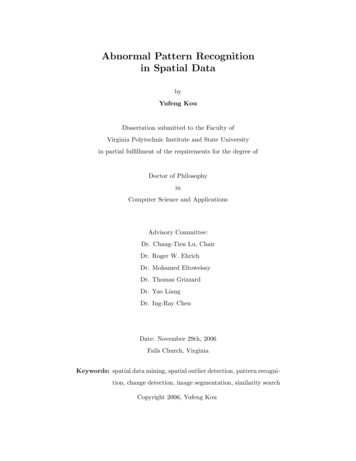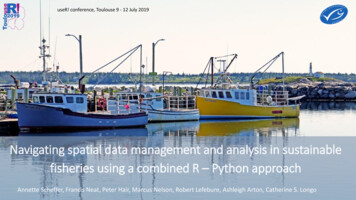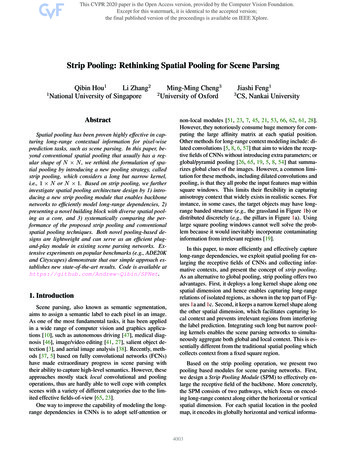
Transcription
Strip Pooling: Rethinking Spatial Pooling for Scene ParsingQibin Hou1Li Zhang21National University of SingaporeMing-Ming Cheng32University of OxfordAbstractSpatial pooling has been proven highly effective in capturing long-range contextual information for pixel-wiseprediction tasks, such as scene parsing. In this paper, beyond conventional spatial pooling that usually has a regular shape of N N , we rethink the formulation of spatial pooling by introducing a new pooling strategy, calledstrip pooling, which considers a long but narrow kernel,i.e., 1 N or N 1. Based on strip pooling, we furtherinvestigate spatial pooling architecture design by 1) introducing a new strip pooling module that enables backbonenetworks to efficiently model long-range dependencies, 2)presenting a novel building block with diverse spatial pooling as a core, and 3) systematically comparing the performance of the proposed strip pooling and conventionalspatial pooling techniques. Both novel pooling-based designs are lightweight and can serve as an efficient plugand-play module in existing scene parsing networks. Extensive experiments on popular benchmarks (e.g., ADE20Kand Cityscapes) demonstrate that our simple approach establishes new state-of-the-art results. Code is available athttps://github.com/Andrew-Qibin/SPNet.1. IntroductionScene parsing, also known as semantic segmentation,aims to assign a semantic label to each pixel in an image.As one of the most fundamental tasks, it has been appliedin a wide range of computer vision and graphics applications [10], such as autonomous driving [47], medical diagnosis [46], image/video editing [41, 27], salient object detection [3], and aerial image analysis [38]. Recently, methods [37, 5] based on fully convolutional networks (FCNs)have made extraordinary progress in scene parsing withtheir ability to capture high-level semantics. However, theseapproaches mostly stack local convolutional and poolingoperations, thus are hardly able to well cope with complexscenes with a variety of different categories due to the limited effective fields-of-view [65, 23].One way to improve the capability of modeling the longrange dependencies in CNNs is to adopt self-attention orJiashi Feng13CS, Nankai Universitynon-local modules [51, 23, 7, 45, 21, 53, 66, 62, 61, 28].However, they notoriously consume huge memory for computing the large affinity matrix at each spatial position.Other methods for long-range context modeling include: dilated convolutions [5, 8, 6, 57] that aim to widen the receptive fields of CNNs without introducing extra parameters; orglobal/pyramid pooling [26, 65, 19, 5, 8, 54] that summarizes global clues of the images. However, a common limitation for these methods, including dilated convolutions andpooling, is that they all probe the input features map withinsquare windows. This limits their flexibility in capturinganisotropy context that widely exists in realistic scenes. Forinstance, in some cases, the target objects may have longrange banded structure (e.g., the grassland in Figure 1b) ordistributed discretely (e.g., the pillars in Figure 1a). Usinglarge square pooling windows cannot well solve the problem because it would inevitably incorporate contaminatinginformation from irrelevant regions [19].In this paper, to more efficiently and effectively capturelong-range dependencies, we exploit spatial pooling for enlarging the receptive fields of CNNs and collecting informative contexts, and present the concept of strip pooling.As an alternative to global pooling, strip pooling offers twoadvantages. First, it deploys a long kernel shape along onespatial dimension and hence enables capturing long-rangerelations of isolated regions, as shown in the top part of Figures 1a and 1c. Second, it keeps a narrow kernel shape alongthe other spatial dimension, which facilitates capturing local context and prevents irrelevant regions from interferingthe label prediction. Integrating such long but narrow pooling kernels enables the scene parsing networks to simultaneously aggregate both global and local context. This is essentially different from the traditional spatial pooling whichcollects context from a fixed square region.Based on the strip pooling operation, we present twopooling based modules for scene parsing networks. First,we design a Strip Pooling Module (SPM) to effectively enlarge the receptive field of the backbone. More concretely,the SPM consists of two pathways, which focus on encoding long-range context along either the horizontal or verticalspatial dimension. For each spatial location in the pooledmap, it encodes its globally horizontal and vertical informa-4003
above two pooling-based modules into a single architecture,which achieves significant improvements over the baselinesand establishes new state-of-the-art results on widely-usedscene parsing benchmark datasets.2. Related Work(a)(b)(c)(d)Figure 1. Illustrations on how strip pooling and spatial poolingwork differently for scene parsing. From top to bottom: strippooling; conventional spatial pooling; ground-truth annotations;our results with conventional spatial pooling only; our results withstrip pooling considered. As shown in the top row, compared toconventional spatial pooling (green grids), strip pooling has a kernel of band shape (red grids) and hence can capture long-range dependencies between regions distributed discretely (yellow bounding boxes).tion and then uses the encodings to balance its own weightfor feature refinement. Furthermore, we present a noveladd-on residual building block, called the Mixed Poolingmodule (MPM), to further model long-range dependenciesat high semantic level. It gathers informative contextual information by exploiting pooling operations with differentkernel shapes to probe the images with complex scenes.To demonstrate the effectiveness of the proposed poolingbased modules, we present SPNet which incorporates bothmodules into the ResNet [20] backbone. Experiments showthat our SPNet establishes new state-of-the-art results onpopular scene parsing benchmarks.The contributions of this work are as follows: (i) Weinvestigate the conventional design of the spatial poolingand present the concept of strip pooling, which inherits themerits of global average pooling to collect long-range dependencies and meanwhile focus on local details. (ii) Wedesign a Strip Pooling Module and a Mixed Pooling Module based on strip pooling. Both modules are lightweightand can serve as efficient add-on blocks to be plugged intoany backbone networks to generate high-quality segmentation predictions. (iii) We present SPNet integrating theCurrent state-of-the-art scene parsing (or semantic segmentation) methods mostly leverage convolutional neuralnetworks (CNNs). However, the receptive fields of CNNsgrow slowly by stacking the local convolutional or pooling operators, which therefore hampers them from takingenough useful contextual information into account. Earlytechniques for modeling contextual relationships for sceneparsing involve the conditional random fields (CRFs) [25,49, 1, 67]. They are mostly modeled in the discrete labelspace and computationally expensive, thus are now less successful for producing state-of-the-art results of scene parsing albeit have been integrated into CNNs.For continuous feature space learning, prior work usemulti-scale feature aggregation [37, 5, 33, 18, 42, 31, 32, 2,44, 4, 48, 17] to fuse the contextual information by probingthe incoming features with filters or pooling operations atmultiple rates and multiple fields-of-view. DeepLab [5, 6]and its follow-ups [8, 54, 39] adopt dilated convolutions andfuse different dilation rate features to increase the receptivefiled of the network. Besides, aggregating non-local context[36, 58, 29, 15, 7, 45, 21, 53, 66, 23, 14] is also effective forscene parsing.Another line of research on improving the receptive fieldis the spatial pyramid pooling [65, 19]. By adopting a setof parallel pooling operations with a unique kernel size ateach pyramid level, the network is able to capture largerange context. It has been shown promising on several sceneparsing benchmarks. However, its ability to exploit contextual information is limited since only square kernel shapesare applied. Moreover, the spatial pyramid pooling is onlymodularized on top of the backbone network thus renderingit is not flexible or directly applicable in the network building block for feature learning. In contrast, our proposedstrip pooling module and mixed pooling module adopt pooling kernels with size 1 N or N 1, both of which can beplugged and stacked into existing networks. This differenceenables the network to exploit rich contextual relationshipsin each of the proposed building blocks. The proposed modules have proven to be much more powerful and adaptablethan the spatial pyramid pooling in our experiments.3. MethodologyIn this section, we first give the concept of strip poolingand then introduce two model designs based on strip pooling to demonstrate how it improves scene parsing networks.Finally, we describe the entire architecture of the proposed24004
fusionstrip pool1 WH Wstrip poolSigmoidexpandH W1 1 Conv1D ConvH Wexpand1D ConvH 1H WH WIdentityinput tensoroutput tensorFigure 2. Schematic illustration of the Strip Pooling (SP) module.scene parsing network augmented by strip pooling.3.1. Strip PoolingBefore describing the formulation of strip pooling, wefirst briefly review the average pooling operation.Standard Spatial Average Pooling: Let x RH W bea two-dimensional input tensor, where H and W are thespatial height and width, respectively. In an average poolinglayer, a spatial extent of the pooling (h w) is required.Consider a simple case where h divides H and w divides W .Then the output y after pooling is also a two-dimensionalWtensor with height Ho Hh and width Wo w . Formally,the average pooling operation can be written asyio ,jo X1h wXxio h i,jo w j ,(1)Similarly, the output yv RW after vertical strip poolingcan be written as1 Xxi,j .(3)yjv H0 i HGiven the horizontal and vertical strip pooling layers, itis easy to build long-range dependencies between regionsdistributed discretely and encode regions with the bandedshape, thanks to the long and narrow kernel shape. Meanwhile, it also focuses on capturing local details due to itsnarrow kernel shape along the other dimension. These properties make the proposed strip pooling different from conventional spatial pooling that relies on square-shape kernels. In the following, we will describe how to leveragestrip pooling (Eqn. 2 and Eqn. 3) to improve scene parsingnetworks.0 i h 0 j wwhere 0 io Ho and 0 jo Wo . In Eqn. 1, eachspatial location of y corresponds to a pooling window ofsize h w. The above pooling operation has been successfully applied to previous work [65, 19] for collectinglong-range context. However, it may unavoidably incorporate lots of irrelevant regions when processing objects withirregular shapes as shown in Figure 1.Strip Pooling: To alleviate the above problem, we presentthe concept of ‘strip pooling’ here, which uses a band shapepooling window to perform pooling along either the horizontal or the vertical dimension, as shown in the top row ofFigure 1. Mathematically, given the two-dimensional tensor x RH W , in strip pooling, a spatial extent of pooling(H, 1) or (1, W ) is required. Unlike the two-dimensionalaverage pooling, the proposed strip pooling averages allthe feature values in a row or a column. Thus, the outputyh RH after horizontal strip pooling can be written asyih 1WXxi,j .3.2. Strip Pooling ModuleIt has been demonstrated in previous work [8, 16] thatenlarging the receptive fields of the backbone networks isbeneficial to scene parsing. In this subsection, motivatedby this fact, we introduce an effective way to help backbone networks capture long-range context by exploitingstrip pooling. In particular, we present a novel Strip Poolingmodule (SPM), which leverages both horizontal and vertical strip pooling operations to gather long-range contextfrom different spatial dimensions. Figure 2 depicts our proposed SPM. Let x RC H W be an input tensor, whereC denotes the number of channels. We first feed x intotwo parallel pathways, each of which contains a horizontalor vertical strip pooling layer followed by a 1D convolutional layer with kernel size 3 for modulating the currentlocation and its neighbor features. This gives yh RC Hand yv RC W . To obtain an output z RC H W thatcontains more useful global priors, we first combine yh andyw together as follows, yielding y RC H W :(2)hvyc,i,j yc,i yc,j.0 j W34005(4)
Then, the output z is computed asz Scale(x, σ(f (y))),(5)where Scale(·, ·) refers to element-wise multiplication, σis the sigmoid function and f is a 1 1 convolution. Itshould be noted that there are multiple ways to combinethe features extracted by the two strip pooling layers, suchas computing the inner product between two extracted 1Dfeature vectors. However, taking the efficiency into accountand to make the SPM lightweight, we adopt the operationsdescribed above, which we find still work well.In the above process, each position in the output tensoris allowed to build relationships with a variety of positionsin the input tensor. For example, in Figure 2, the squarebounded by the black box in the output tensor is connectedto all the locations with the same horizontal or vertical coordinate as it (enclosed by red and purple boxes). Therefore, by repeating the above aggregation process a couple oftimes, it is possible to build long-range dependencies overthe whole scene. Moreover, benefiting from the elementwise multiplication operation, the proposed SPM can alsobe considered as an attention mechanism and directly applied to any pretrained backbone networks without trainingthem from scratch.Compared to global average pooling, strip pooling considers long but narrow ranges instead of the whole featuremap, avoiding most unnecessary connections to be built between locations that are far from each other. Compared toattention-based modules [16, 19] that need a large amountof computation to build relationships between each pair oflocations, our SPM is lightweight and can be easily embedded into any building blocks to improve the capability ofcapturing long-range spatial dependencies and exploitinginter-channel dependencies. We will provide more analysis on the performance of our approach against existingattention-based methods.essential for scene parsing networks. For long-range dependencies, unlike previous work [60, 65, 8] that use theglobal average pooling layer, we propose to gather suchkind of clues by employing both horizontal and verticalstrip pooling operations. A simplified diagram can be foundin Figure 3(b). As analyzed in Section 3.2, the strip pooling makes connections among regions distributed discretelyover the whole scene and encoding regions with bandedstructures possible. However, for cases where semantic regions are distributed closely, spatial pooling is also necessary for capturing local contextual information. Takingthis into account, as depicted in Figure 3(a), we adopt alightweight pyramid pooling sub-module for short-rangedependency collection. It has two spatial pooling layersfollowed by convolutional layers for multi-scale feature extraction plus a 2D convolutional layer for original spatialinformation preserving. The feature maps after each pooling are with bin sizes of 20 20 and 12 12, respectively.All three sub-paths are then combined by summation.Based on the above two sub-modules, we propose to nestthem into residual blocks [20] with bottleneck structure forparameter reduction and modular design. Specifically, before each sub-module, a 1 1 convolutional layer is firstused for channel reduction. The outputs from both submodules are concatenated together and then fed into another1 1 convolutional layer for channel expansion as done in[20]. Note that all convolutional layers, aside from the onesfor channel reduction and expansion, are with kernel size3 3 or 3 (for 1D convolutional layers).It is worth mentioning that unlike the spatial pyramidpooling modules [65, 8], the proposed MPM is a kind ofmodularized design. The advantage is that it can be easilyused in a sequential way to expand the role of the long-rangedependency collection sub-module. We find that with thesame backbone our network with only two MPMs (around1/3 parameters of the original PPM [65]) performs even better than the PSPNet. In our experiment section, we will provide more results and analysis on this.3.3. Mixed Pooling ModuleIt turns out that the pyramid pooling module (PPM) isan effective way to enhance scene parsing networks [65].However, PPM heavily relies on the standard spatial poolingoperations (albeit with different pooling kernels at differentpyramid levels), making it still suffers as analyzed in Section 3.1. Taking into account the advantages of both standard spatial pooling and the proposed strip pooling, we advance the PPM and design a Mixed Pooling Module (MPM)which focuses on aggregating different types of contextualinformation via various pooling operations to make the feature representations more discriminative.The proposed MPM consists of two sub-modules thatsimultaneously capture short-range and long-range dependencies among different locations, which we find are both3.4. Overall ArchitectureBased on the proposed SPM and MPM, we introduce anoverall architecture, called SPNet, in this subsection. Weadopt the classic residual networks [20] as our backbones.Following [5, 65, 16], we improve the original ResNet withthe dilation strategy and the final feature map size is set to1/8 of the input image. The SPMs are added after the 3 3convolutional layer of the last building block in each stageand all building blocks in the last stage. All convolutionallayers in an SPM share the same number of channels to theinput tensor.For the MPM, we directly build it upon the backbonenetwork because of its modular design. Since the outputof the backbone is with 2048 channels, we first connect a44006
2D ConvUPSettings#ParamsSPMmIoUPixel AccUPBase FCNBase FCN PPM [65]27.7 M 21.0 M 37.6341.6877.60%80.04%Base FCN 1 MPMBase FCN 2 MPMBase FCN 2 MPM 4.4 M 8.8 M 11.9 M 40.5041.9244.0379.60%80.03%80.65%2D Conv2D Conv2D Conv1D Conv1D ConvUPUP2D Conv(a)(b)Figure 3. (a) Short-range dependency aggregation sub-module. (b)Long-range dependency aggregation sub-module. Inspired by [34,35], a convolutional layer is added after the fusion operation ineach sub-module to reduce the aliasing effect brought by downsampling operations.1 1 convolutional layer to the backbone to reduce the output channels from 2048 to 1024 and then add two MPMs.In each MPM, following [20], all convolutional layers withkernel size 3 3 or 3 have 256 channels (i.e., a reductionrate of 1/4 is used). A convolutional layer is added at theend to predict the segmentation map.4. ExperimentsWe evaluate the proposed SPM and MPM on popular scene parsing datasets, including ADE20K [68],Cityscapes [11], and Pascal Context [40]. Moreover, wealso conduct comprehensive ablation analysis on the effectof the proposed strip pooling based on the ADE20K datasetas done in [65].4.1. Experimental SetupOur network is implemented based on two public toolboxes [64, 59] and Pytorch [43]. We use 4 GPUs to run allthe experiments. The batch size is set to 8 for Cityscapesand 16 for other datasets during training. Following mostprevious works [5, 65, 60], we adopt the ‘poly’ learning rateiterpowerpolicy (i.e., the base one multiplying (1 max) initer )training. The base learning rate is set to 0.004 for ADE20Kand Cityscapes datasets and 0.001 for the Pascal Contextdataset. The power is set to 0.9. The training epochs areas follows: ADE20K (120), Cityscapes (180), and PascalContext (100). Momentum and weight decay rate are set to0.9 and 0.0001, respectively. We use synchronized BatchNormalization in training as done in [60, 65].For data augmentation, similar to [65, 60], we randomlyTable 1. Ablation analysis on the number of mixed pooling modules (MPMs). ‘SPM’ refers to the strip pooling module. As canbe seen, when more MPMs are used, better results are yielded. Allresults are based on ResNet-50 backbone and single-model test.Best result is highlighted in bold.flip and rescale the input images from 0.5 to 2 and finallycrop the image to a fixed size of 768 768 for Cityscapesand 480 480 for others. By default, we report results under the standard evaluation metric—mean Intersection ofUnion (mIoU). For datasets with no ground-truth annotations available, we get results from the official evaluationservers. For all experiments, we use cross-entropy loss tooptimize all models. Following [65], we exploit an auxiliaryloss (connected to the last residual block of the forth stage)and the loss weight is set to 0.4. We also report multi-modelresults to fairly compare our approach with others, i.e., averaging the segmentation probability maps from multiple image scales {0.5, 0.75, 1.0, 1.25, 1.5, 1.75} as in [32, 65, 60].4.2. ADE20KThe ADE20K dataset [68] is one of the most challenging benchmarks, which contains 150 classes and a varietyof scenes with 1,038 image-level labels. We follow the official protocal to split the whole dataset. Like most previousworks, we use both pixel-wise accuracy (Pixel Acc.) andmean of Intersection over Union (mIoU) for evaluation. Wealso adopt multi-model test and use the averaged results forevaluation following [32, 65]. For ablation experiments, weadopt ResNet-50 as our backbone as done in [65]. Whencomparing with prior works, we use ResNet-101.4.2.1Ablation StudiesNumber of MPMs: As stated in Section 3.3, the MPM isbuilt based on the bottleneck structure of residual blocks[20] and hence can be easily repeated multiple times to expand the role of strip pooling. Here, we investigate howmany MPMs are needed to balance the performance andthe runtime cost of the proposed approach. As shown in Table 1, we list the results when different numbers of MPMsare used based on the ResNet-50 backbone. One can seewhen no MPM is used (base FCN), we achieve a result of37.63% in terms of mIoU. When 1 MPM is used, we havea result of 40.50%, i.e. around 3.0% improvement. Fur54007
Settingsw/ SPM mIoU Pixel AccBase FCNBase FCN 2 MPM (SRD only)Base FCN 2 MPM (LRD only) 37.6340.5041.1477.60%79.34%79.64%Base FCN 2 MPM (SRD LRD)Base FCN 2 MPM (SRD LRD) 41.9244.0380.03%80.65%Table 2. Ablation analysis on the mixed pooling module (MPM).‘SPM’ refers to the strip pooling module. ‘SRD’ and ‘LRD’ denote the short-range dependency aggregation sub-module and thelong-range dependency aggregation sub-module, respectively. Ascan be seen, collecting both short-range and long-range dependencies are essential for yielding better segmentation results. Allresults are based on single-model test.thermore, when we add two MPMs to the backbone, a performance gain of around 4.3% can be obtained. However,adding more MPMs gives trivial performance gain. Thismay be because the receptive field is already large enough.As a result, regarding the runtime cost, we set the numberof MPMs to 2 by default.To show the advantages of the proposed MPM over PPM[65], we also show the result and the parameter numberof PSPNet in Table 1. It can be easily seen that the setting of ‘Base FCN 2 MPM’ already performs better thanPSPNet despite 12M fewer parameters than PSPNet. Thisphenomenon demonstrates that our modularized design ofMPM is much more effective than PPM.Effect of strip pooling in MPMs: It has been describedin Section 3.3 that the proposed MPM contains two submodules for collecting short-range and long-range dependencies, respectively. Here, we ablate the importance ofthe proposed strip pooling. The corresponding results areshown in Table 2. Obviously, collecting long-range dependencies with strip pooling (41.14%) is more effective thancollecting only short-range dependencies (40.5%), but gathering both of them further improves (41.92%). To furtherdemonstrate how the strip pooling works in MPM, we visualize some feature maps at different positions of MPM inFigure 5 and some segmentation results under different settings of MPM in Figure 4. Clearly, the proposed strip pooling can more effectively collect long-range dependencies.For example, the feature map output from the long-rangedependency aggregation module (LRD) in the top row ofFigure 5 can accurately locate where the sky is. However,global average pooling cannot do this because it encodes thewhole feature map to a single value.Effectiveness of SPMs: We empirically find that there isno need to add the proposed SPM to each building blockof the backbone network despite its light weight. In thisexperiment, we consider four scenarios, which are listed inTable 3. We take the base FCN followed by 2 MPMs as(a) Image(b) GT(c) 2 SRD (d) 2 LRD (e) 2 MPMFigure 4. Visual comparisons among different settings of the MPmodule (MPM). ‘2 SRD’ means we use 2 MPMs with onlythe short-range dependency aggregation module included and ‘2LRD’ means we use 2 MPMs with only the long-range dependency aggregation module included.SettingsBase FCNBase FCN SPMBase FCN SPMBase FCN SE [22]Base FCN SPMBase FCN SPMSPM Position #MPM mIoU Pixel Acc.LA22241.9242.6142.3080.03%80.38%80.22%A LA LA L20241.3441.6644.0380.05%79.69%80.65%Table 3. Ablation analysis on the strip pooling module (SPM). L:Last building block in each stage. A: All building blocks in the laststage. As can be seen, SPM can largely improve the performanceof the base FCN from 37.63 to 41.66.the baseline. We first add an SPM to the last building blockin each stage; the resulting mIoU score is 42.61%. Second, we attempt to add SPMs to all the building blocks inthe last stage, and find the performance slightly declines to42.30%. Next, when we add SPMs to both the above positions, an mIoU score of 44.03% can be yielded. However,when we attempt to add SPMs to all the building blocks ofthe backbone, there is nearly no performance gain already.Regarding the above results, by default, we add SPMs tothe last building block of each stage and all the buildingblocks of the last stage. In addition, when we take only thebase FCN as our baseline and add the proposed SPMs, themIoU score increases from 37.63% to 41.66%, achieving animprovement of nearly 4%. All the above results indicatethat adding SPMs to the backbone network does benefit thescene parsing networks.Strip Pooling v.s. Global Average Pooling: To demonstrate the advantages of the proposed strip pooling over theglobal average pooling, we attempt to change the strip pooling operations in the proposed SPM to global average pooling. Taking the base FCN followed by 2 MPMs as the baseline, when we add SPMs to the base FCN, the performance64008
(a) Image(b) GT(c) After VSP(d) After HSP(e) After LRD(f) After SRD(g) After MPM(h) ResultsFigure 5. Visualization of selected feature maps at different positions of the proposed MP module. VSP: vertical strip pooling; HSP:horizontal strip pooling; SRD: short-range dependency aggregation sub-module (Figure 3a); LRD: long-range dependency aggregationsub-module (Figure 3b); MPM: mixed pooling module.SettingsMulti-Scale FlipmIoU (%)Pixel Acc. (%)SPNet-50SPNet-50 44.0345.0380.6581.32SPNet-101SPNet-101 44.5245.6081.3782.09Table 4. More ablation experiments when different backbone networks are used.increases from 41.92% to 44.03%. However, when wechange the proposed strip pooling to global average pooling as done in [22], the performance drops from 41.92% to41.34%, which is even worse than the baseline as shown inTable 3. This may be due to directly fusing feature maps toconstruct a 1D vector which leads to loss of too much spatial information and hence ambiguity as pointed out in theprevious work [65].More experiment analysis: In this part, we show the influence of different experiment settings on the performance,including the depth of the backbone network and multiscale test with flipping. As listed in Table 4, multi-scale testwith flipping can largely improve the results for both backbones. Moreover, using deeper backbone networks alsobenefits the performance (ResNet-50: 45.03% ResNet101: 45.60%).Visualization: In Figure 6, we show some visual results under different settings of the proposed approach. Obviously,adding either MPM or SPM to the base FCN can effectivelyimprove the segmentation results. When both MPM andSPM are considered, the quality of the segmentation mapscan be further enhanced.4.2.2Comparison with the State-of-the-ArtsHere, we compare the proposed approach with previousstate-of-the-art methods. The results can be found in Table 5. As can be seen, our approach with ResNet-50 asbackbone reaches an mIoU score of 45.03% and pixel ac-MethodBackbonemIoU (%) Pixel Acc. (%) ScoreRefineNet [32]PSPNet [65]PSPNet [65]SAC [63]EncNet [60]DSSPN [30]UperNet [52]PSANet [66]CCNet [23]APNB [69]APCNet 1.51-62.3463.3263.0863.1762.4161.8462.64-SPNet (Ours)SPNet 63.85Table 5. Comparisons with the state-of-the-arts on the validationset of ADE20K [68]. We report both mIoU and Pixel Acc. on thisbenchmark. Best results are highlighted in bold.curacy of 81.32%, which are already better than most of theprevious methods. When taking ResNet-101 as our backbone, we achieve new state-of-the-art results in terms ofboth mIoU and pixel accuracy.4.3. CityscapesCityscapes [11] is another popular dataset for sceneparsing, which contains totally 19 classes. It consists of5K high-quality pixel-annotated ima
scene parsing benchmark datasets. 2. Related Work Current state-of-the-art scene parsing (or semantic seg-mentation) methods mostly leverage convolutional neural networks (CNNs). However, the receptive fields of CNNs grow slowly by stacking the local convolutional or pool-ing operators, which therefore hampers them from taking
